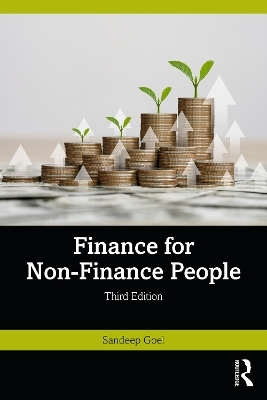
Finance for Non-Finance People
Routledge India (Verlag)
978-1-032-85050-4 (ISBN)
Discusses fundamental concepts and applications of accounting and finance at the global level
Contains effective tools for financial analysis, communication, monitoring and resource allocation
Provides important instructional aids such as figures, tables, illustrations and real-world corporate case studies to facilitate learning
Is concise in form yet comprehensive in content, delivering in-depth coverage of the five key constituents and entire gamut of the finance domain – financial accounting, cost accounting, financial management, financial markets and tax planning
Is thoroughly updated with the latest concepts, international corporate practices, recent trends and current data with a vivid visual impact for a pleasurable reading and learning experience.
Lucid, accessible and comprehensive, this third edition is a revised version in accordance with the current finance laws, practices and data. A guide to building financial acumen and literacy, it will be a useful resource for executive and management development programmes (EDPs & MDPs) oriented towards business managers and management students, including MBA programmes, and allied disciplines of commerce, finance, economics and others. It will also benefit business executives, corporate heads, entrepreneurs, government officials, academicians of business and allied disciplines, as well as those who deal with finance or financial matters in their daily lives.
Sandeep Goel is a Professor of Accounting and Finance and Corporate Governance at the Management Development Institute (MDI) Gurgaon, India. He holds three decades of rich industry and academic experience, and is an accomplished Forensic Accounting, Fraud Risk Management and Corporate Governance professional.
List of figures xv
List of tables xvii
About the Author xix
Preface xxi
Acknowledgements xxvi
Abbreviations xxviii
PART I
Introduction 1
1 Business organisations 3
Meaning of a business organisation 3
Types of business organisations 3
I. Private sector enterprise 4
II. Public sector enterprise 4
III. Joint sector enterprise 4
Types of private sector enterprises 5
1. Sole proprietorship 5
2. Joint Hindu family business 5
3. Partnership 5
4. Cooperative organisation 5
5. Joint stock company 5
6. One person company 7
Types of public sector enterprises 8
Departmental undertakings 8
Statutory corporations 9
Government companies 9
PART II
Financial accounting and analysis 11
2 Fundamentals of accounting 13
Meaning of accounting 13
Branches of accounting 14
1. Financial accounting 14
2. Cost accounting 14
3. Management accounting 15
Objectives of accounting 15
Limitations of accounting 15
Accounting elements 16
Double-entry system of accounting 18
Basis of accounting 21
3 Accounting process 24
Accounting cycle 24
1. Recording in the ‘Journal’ 26
2. Classification into the ‘Ledger’ 28
3. Summarising in ‘Trial Balance’ 31
4 Accounting principles 33
Basic accounting principles 34
A. Accounting concepts 34
1. Business entity principle 34
2. Money measurement principle 35
3. Accounting period principle 35
4. Cost principle 36
5. Going concern principle 36
6. Matching principle 37
7. Revenue recognition principle 37
8. Dual aspect principle 37
B. Accounting conventions 38
1. Materiality 38
2. Full disclosure 38
3. Consistency 39
4. Conservatism 39
5 Financial statements 41
Financial statements 41
Statement of profit and loss 42
1. Revenue from operations (Turnover/sales) 43
2. Other income 43
3. Operating expenses 44
4. Finance costs/Non-operating expenses 45
5. Other expenses 45
6. Profit before tax/earnings before tax (PBT/EBT) 45
7. Income tax 45
8. Profit after tax (PAT) 45
Balance sheet 48
I Assets side of balance sheet 49
II Liabilities side of balance sheet 52
Depreciation accounting 55
Depreciation methods 56
1. Straight Line Method (SLM) 56
2. Written-Down-Value Method (WDV) 56
3. Other Depreciation Methods 57
Statement of cash flows 58
A. Steps to calculate CFO: 60
B. Steps to calculate CFI and CFF: 60
C. Final Step to prepare CFS: 60
Other disclosures in annual report 62
Components of a company’s annual report 62
6 Financial analysis 65
Financial analysis: The concept and process 66
1. Common-size analysis 66
2. Trend analysis 69
3. Ratio analysis 71
Ranking and weight based on the DuPont scores 77
Financial analysis of Maruti Suzuki and Tata Motors 78
Indian automobile sector 78
I Profitability analysis of Maruti Suzuki and Tata Motors 82
Operating efficiency analysis of Maruti Suzuki and Tata
Motors 88
Liquidity analysis of Maruti Suzuki and Tata Motors 91
Solvency analysis of Maruti Suzuki and Tata Motors 94
Market analysis of Maruti Suzuki and Tata Motors 96
Corporate cases 98
I Indian telecom sector 99
II Indian banking sector 102
Global landscape 105
A. Apple Inc. (USA) 106
B. Unilever (UK) 107
PART III
Cost accounting and management 109
7 Cost concepts and classification 111
Cost accounting 111
Significance of cost accounting 112
Cost! 112
Elements of cost 113
Cost unit 114
Cost centres 115
Process of costing 115
Cost classification 116
1. On the basis of traceability 116
2. On the basis of association 116
3. On the basis of nature 117
4. On the basis of controllability 117
5. On the basis of decision-making 118
Components of total cost 118
1. Prime cost 118
2. Factory cost 118
3. Office cost 118
4. Total cost/cost of sales 119
Cost sheet 119
Methods of costing 120
1. Job costing 120
2. Process costing 121
Techniques of costing 121
1. Budgetary control 121
2. Standard costing 122
3. Marginal costing 122
4. Absorption costing 122
8 Budgetary control 124
Budgeting 124
Budget 124
Budgetary control 125
Process of budgetary control 125
Types of budgets 126
A. On the basis of time 126
B. On the basis of functions 127
C. On the basis of flexibility 128
Essentials of good budgeting 130
Caselets of different budgets 131
1. Manufacturing overhead budget 131
2. Sales overhead budget 131
3. Cash budget 132
9 Marginal costing and managerial decision-making 135
Marginal cost 135
Marginal costing 136
Cost-Volume-Profit analysis (CVP analysis) 137
Tools of CVP analysis 137
(a) Contribution 137
(b) Contribution margin/P/V ratio 138
(c) Break-even point 138
(d) Margin of safety 140
Managerial decision-making 141
1. Pricing decisions 141
2. Key factor 143
3. Profit planning 144
4. Make or buy 145
5. Continue or discontinue? 147
6. Selection of the best method of production 148
PART IV
Financial management 151
10 Nature of financial management 153
What is financial management? 153
Elements 153
Objectives of financial management 154
Functions of financial management 154
Financial management scenario in India 155
Financial management problems 156
11 Capital budgeting: Concept and application 158
Meaning of capital budgeting 158
Capital budgeting process 159
Capital budgeting projects 160
Indian realty sector 161
12 Time value of money 165
What is time value of money? 165
Methods of valuation 166
A. Compounding – ‘future value’ (FV) 166
B. Discounting – ‘present value’ (PV) 169
13 Estimation of cash flows for capital expenditures 173
Cash flows estimation 173
1. Relevant cash flows 174
2. Incremental cash flows 175
14 Capital budgeting appraisal methods 181
I Non-discounted cash flow techniques 182
1. PBP 182
2. ARR 183
II DCF techniques 184
1. Discounted PBP 184
2. NPV 185
3. PI/Benefit-cost ratio (B/C ratio) 187
4. IRR 188
Case: Indian Cloth Mills Ltd. 190
15 Cost of capital 196
What is cost of capital? 196
Classification of costs 197
Computation of cost of capital 197
I Computation of specific costs 197
Beta coefficient and its application 200
Categories of beta 201
II Assigning weights to specific costs 202
III Multiplication of specific costs with weights to get total cost 203
16 Capital structure planning 205
Capital structure defined 206
Types of business finance 206
1. Long-term finance 206
2. Medium-term finance 206
3. Short-term finance 207
Instruments of finance 207
1. Shares 208
2. Retained earnings 208
3. Debentures 208
4. Institutional finance 208
5. Public deposits 208
6. Bank finance 208
Factors affecting capital structure 209
1. Profitability 209
2. Liquidity 209
3. Cost of raising capital 209
4. Stability of enterprise 209
5. Control 209
6. Flexibility of financial structure 209
7. Capital market conditions 210
8. Legal requirements 210
Concept of leverage 210
Leverage ratio 210
Factors determining financial leverage 211
Capital structure analysis of UltraTech Cement and Shree Cement 212
Indian cement industry 213
17 Working capital management 217
Meaning of working capital 217
Concept of working capital 219
1. Gross working capital 219
2. Net working capital 220
Constituents of working capital 220
A. Current assets 220
B. Current liabilities 221
Estimation of working capital 221
Types of working capital 223
1. Permanent working capital 223
2. Temporary working capital 223
Determinants of working capital 224
1. Nature and size of business 224
2. Manufacturing cycle 224
3. Production policy 224
4. Firm’s credit policy 224
5. Sales growth 224
6. Business cycle 224
Types of working capital policy 225
1. Aggressive working capital policy 225
2. Conservative working capital policy 225
3. Matching working capital policy 226
Working capital management: The concept 227
Significance of working capital management 228
Working capital analysis of Nestle India and Dabur
India 228
Indian FMCG sector 229
18 Dividend policy 232
Dividend policy: Overview 232
Forms of dividends 233
Procedure for cash dividend payment 234
1. Recommendation by board of directors 234
2. Approval by the shareholders 234
3. Dividend – ‘interim dividend’ 235
4. Dividend to be deposited in a separate bank account 235
Determinants of dividend policy 235
A. External factors 235
B. Internal factors 236
Dividend policies: Types 237
I Constant dividend per share (DPS) policy 237
II Constant dividend payout policy 238
III Long-run residual dividend policy 238
IV Hybrid dividend policy 239
Dividend policy of HUL and Dabur India 239
Indian FMCG sector 239
PART V
Financial markets 245
19 Financial System: Constituents and instruments 247
Financial markets: Overview 247
1 Based on the nature of securities 248
2 Based on the timing of issue 248
Financial Regulatory institutions 248
1. Reserve Bank of India (RBI) 249
2. Securities and Exchange Board of India (SEBI) 249
A. Markets based on types of securities 250
I. Money market 250
II. Capital market 252
B. Markets based on issue of securities 255
I. Primary market 255
II. Secondary market 256
C. Other markets 256
Derivatives market 257
20 Mutual funds 260
What are mutual funds? 260
Growth of mutual funds 261
Types of mutual funds 261
1. Based on structure 262
2. Based on investment objective 263
3. Based on special schemes 263
Importance of mutual funds 264
PART VI
Tax planning 267
21 Income tax 269
Indian tax structure: Overview 269
Revenue authority 270
Direct vs. indirect tax: Distinction 270
Basic terminologies under Income Tax Act, 1961 271
Income tax classification 274
A. Salaries [Sec. 15] 274
B. Income from house property [Sec. 22] 275
C. Profits and gains of business or profession [Sec. 28] 275
D. Capital gains [Sec. 45] 276
E. Income from other sources [Sec. 56] 276
Computation of tax liability 278
1. Individual Tax 279
2. Cooperative society tax 281
3. Partnership firm tax 282
4. Local authority tax 282
5. Corporate tax 282
Appendix I: Future/Compound value factor of a lump sum (FVIF/CVIF) of Re 1, FVIF(i, n) 288
Appendix II: Future/Compound value factor of an annuity (FVIFA/CVIFA) of Re 1, FVIFA(i, n) 290
Appendix III: Present value factor of a lump sum (PVIF) of Re 1, PVIF(i, n) 292
Appendix IV: Present value factor of an annuity (PVIFA) of Re 1, PVIFA(i, n) 294
Glossary 296
Index 310
| Erscheinungsdatum | 21.08.2024 |
|---|---|
| Zusatzinfo | 52 Tables, black and white; 34 Line drawings, black and white; 1 Halftones, black and white; 35 Illustrations, black and white |
| Verlagsort | London |
| Sprache | englisch |
| Maße | 156 x 234 mm |
| Gewicht | 644 g |
| Themenwelt | Naturwissenschaften ► Geowissenschaften ► Geografie / Kartografie |
| Sozialwissenschaften ► Soziologie ► Spezielle Soziologien | |
| Wirtschaft ► Betriebswirtschaft / Management ► Finanzierung | |
| Wirtschaft ► Betriebswirtschaft / Management ► Rechnungswesen / Bilanzen | |
| Wirtschaft ► Betriebswirtschaft / Management ► Unternehmensführung / Management | |
| ISBN-10 | 1-032-85050-7 / 1032850507 |
| ISBN-13 | 978-1-032-85050-4 / 9781032850504 |
| Zustand | Neuware |
| Informationen gemäß Produktsicherheitsverordnung (GPSR) | |
| Haben Sie eine Frage zum Produkt? |
aus dem Bereich


